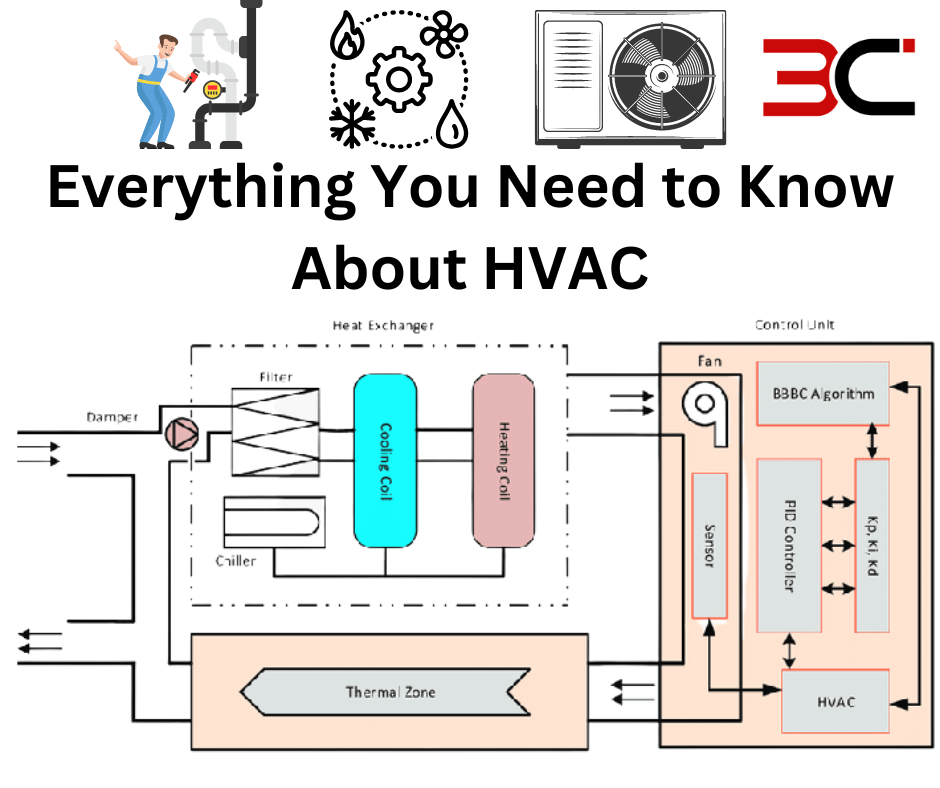HVAC (heating, ventilation, and air conditioning) systems are encountered by company experts seeking commercial cooling solutions. Although these systems employ essentially the same method to maintain the needed temperatures, there are several important distinctions that should be taken into account when choosing the best system for a commercial site.
If you are looking to learn more about the HVAC system, then you have come to the right place. We will break down everything related to the HVAC system, So, read till the end.
What is HVAC (Refrigeration and Air Conditioning)?
Heating, Ventilation, and Air Conditioning are referred to as HVAC. Mechanical engineering’s subfield of HVAC system design is founded on the laws of thermodynamics, fluid mechanics, and heat transport. It is employed to regulate the temperature, humidity, and cleanliness of the air in a confined environment.
Its other abbreviations are HVAC&R or HVACR when the term “Refrigeration” is added, or HACR when the “Ventilation” part is dropped.
Residential buildings and various constructions depend heavily on HVAC systems. These include family homes, apartment complexes, hotels, senior living facilities, medium to large industrial buildings, towers, and hospitals. Additionally, it is utilized for many other kinds of vehicles, including automobiles, trains, aircraft, ships, and submarines. All in all, HVAC is required in buildings where humidity and temperature are safely and properly controlled using outside air.
The Purpose of HVAC Systems
Air pollution is widespread. You and your family might become ill if you allow polluted air into your house without first purifying it. The fact that there are multiple seasons also means that temperatures can range from very cold to very hot. Regardless of the outside weather, having a Heating, Ventilation, and Air Conditioning (commonly known as HVAC) system guarantees you can maintain a pleasant temperature in your house. The key purposes of the HVAC system are to clean the air and control the interior air by cooling or warming it to make it more comfortable.
Use of HVAC
Modern air conditioners use refrigeration cycles to cool an interior environment. By regulating the level of energy of the refrigerant, the refrigeration cycle typically operates. But it is not as easy as it sounds. To regulate the proper temperature in an enclosed space, there is no better alternative than the HVAC system.
Without further ado, let’s take a look at the uses of the HVAC system on individual systems and distributed networks –
On Individual Systems
The functionality of the installation, architecture and control systems in modern buildings must be controlled by one or more HVAC systems. Contractors often calculate the capacity and appropriate system type for small buildings after choosing the proper refrigerant and necessary components. After that, they begin designing the system.
More significant buildings’ HVAC systems must be evaluated, designed, and specified by a team of experts. These experts might be mechanical engineers, building services engineers, or building services designers. The systems are then manufactured, installed, and commissioned by specialized mechanical suppliers and contractors. All structures, regardless of size, typically need construction permits. At the same time, installations must pass inspections for code compliance.
On Distributed Networks
Although HVAC systems are used in specific buildings or other enclosed areas, they are part of a broader network for district heating or cooling. The DHC (District Heating and Cooling) network can also be integrated. In such circumstances, the operating and maintenance components are streamlined, and metering is required to charge for the utilized energy. In some situations, the energy is transferred back to the larger system.
By basing HVAC on a broader network, it is feasible to achieve economies of scale that are sometimes impossible for single buildings. Making use of natural resources for HVAC systems can have a significant impact on the environment.
The Main Three Sections of the HVAC System
Now that we have discussed the usage of the HVAC system in different sections, it won’t be fair if we don’t talk about the main three components of the HVAC system.
Heating
Appliances called heaters are designed to produce heat for a building. Central heating is a viable option for this. A steam, heat pump, furnace, and boiler are all components of such a system. The system can also store air in a central area, such as a big building’s mechanical room or a home’s furnace room. Whereas, a single-unit space heater is used to heat a single room.
There are three ways to move heat –
- Convection
- Conduction
- Radiation
Ventilation
Ventilation is the practice of altering or refreshing the air in a room to regulate the temperature. It is one of the most crucial elements in maintaining buildings’ appropriate levels of indoor air quality. Ventilation refills oxygen in the air by eliminating any mixture of moisture, smells, airborne bacteria, smoke, dust, heat, or carbon dioxide.
Ventilation is the term used to describe the deliberate introduction of outside air into a building’s interior. Proper ventilation techniques may be categorized into two categories:
- Natural ventilation
- Open air circulation (forged ventilation)
Air Conditioning
A building’s whole interior or a specific area can be cooled or have its humidity controlled by an air conditioning system. In this arrangement, a vent typically draws in clean air from the outside. It enters a container with mixed air, which is combined with the air from space. The air is then cooled as it enters an interior or outdoor heat exchanger segment. By changing the aperture of this vent, one can often control the proportion of fresh air in the return air.
- 10% of the entire air supply is usually consumed as fresh air
Refrigeration and air conditioning are made possible by removing heat. A refrigeration system acts as a heat transfer medium. Air, water, ice, and chemicals can all be considered refrigerants. Air-conditioned buildings frequently feature sealed windows due to the fact that open windows would interfere with the system designed to maintain consistent internal air conditions.
Different Parts of the HVAC System
An HVAC system’s three primary components — heating, ventilation, and air conditioning — are interconnected, particularly when it comes to delivering appropriate thermal comfort and indoor air quality. You should be familiar with the nine HVAC system components listed below.
- Air Return
The HVAC system’s air return function signals the beginning of the ventilation cycle. This takes air in, filters it, and then delivers it to the primary system.
- Filter
It is a significant component of the HVAC system, through which air is pulled.
- Exhaust Outlets
The exhaust ports, which release the exhaust produced by the heating system, are a crucial component of the HVAC system.
- Ducts
The passages via which air is heated or cooled are called ducts.
- Electrical Elements
This area of the HVAC system can be a little difficult, and issues frequently start here.
- Outdoor Unit
When someone describes an HVAC system, they immediately picture the outdoor unit. The fan that moves air is housed in the outdoor unit.
- Compressor
The compressor transforms the refrigerant from a gas to a liquid before delivering it to the coils. It plays a significant role in the outdoor unit.
- Coils
A small amount of refrigerant is used by the coils to chill the air as it passes through slightly. Normally, it is an additional component of the outdoor unit.
- Blower
Heated air is drawn into the main part of the device by the blower.
The Difference Between HVAC and Commercial Air Conditioning
We will differentiate between HVAC and commercial AC with the following table –
| Topic | HVAC | AC |
| Abbreviation | Heating, Ventilation, and Air Conditioning | Air Conditioning |
| Main Function | The systems that control the temperature in confined places are indicated. | It alludes to technologies that are frequently employed to keep buildings cool during the sweltering summer. |
| Work Principal | HVAC works similarly to an air conditioner. Except that the principals are better. | To stop or impede the growth of hazardous germs, it maintains a low temperature that is frequently lower than the surrounding air’s temperature. |
| Components | Basically, it consists of 9 components. | Made of various components, such as a condenser, compressor, capillary tube, evaporator, and thermostat. |
| Air circulation | Supply and return air ducts are used in HVAC systems. | AC employs the same air circulation system, with the exception of ductless AC units. |
Conclusion
Hopefully, you have learned a lot about the HVAC (refrigeration and air conditioning) system if you have come this far. Don’t get confused thinking the HVAC system and typical refrigeration systems are alike. They may contain some common parts and have some similar usage, but they are not the same, to be specific.
If you own or manage a business, you should be fully aware of how crucial it is to have a commercial air conditioning and refrigeration system in excellent working order.

